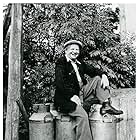You know the scene in all of those TV sitcoms and low-brow comedies of the 50's and 60's where one guy says something to another guy about going to see 'one of them foreign movies' wink, wink, nudge, nudge? Well, the winking and nudging probably wasn't over Gunnar Bjönstrand playing chess with death.
Screened at one of the 'Archive Nights' at this year's ImageOut: The Rochester Lesbian & Gay Film Festival, Time of Desire is the Swedish equivalent of something like A Summer Place- sex, a little comedy, and a lot of melodrama. The story concerns two sisters who live an idyllic life in the countryside, riding horses and frolicking in the forest. They're close. Very close. Wink, wink, nudge, nudge. Their relationship is disrupted when the younger sister falls in love with a man who arrives in their village on business, leaving the older sister emotionally distraught. Comic relief is provided by the lusty escapades of the girls' widowed father and the various household servants.
Content-wise, the film isn't as far removed from American melodramas of the time as one might think: Troy Donohue, Sandra Dee and Lana Turner were starring in stories almost as racy in Hollywood. The movie is slower than its American cousins- in general, European films of the period had lots of footage of peasants frolicking in the countryside, demonstrating how happy and free they were. Lesbian incest aside, the movie does have a distinctively European attitude towards sex (or at least what Americans in 1954 thought of as a 'distinctly European attitude'), presenting it as something that is both good and fun. And the film does have a genuinely startling third act twist- in the 1950's, there were two options for gay characters on film- either repent and go straight, or commit suicide; this film happily (or creepily, depending on how literally you take the story) finds a third option.
Time of Desire had its U.S. premiere in 1958, and reportedly received fairly good reviews. It then disappeared for nearly 5 decades, before a festival programmer tracked down the last existing complete print in a European archive. This sort of find is always exciting and worthy of celebration- however, while I heartily maintain all films are worthy of preservation, not all films are worthy of veneration; and just because something is Swedish, black and white, and hasn't been seen in 50 years doesn't mean it's a work of art. Time of Desire is an interesting curio, but it's asking too much of its serviceable plot and production to be a great cinematic discovery. Originally released with the tag line 'The Film that Shocked Three Continents!', 50 years later it can best be described as 'mildly titillating three continents, before gently lulling them to sleep.'











